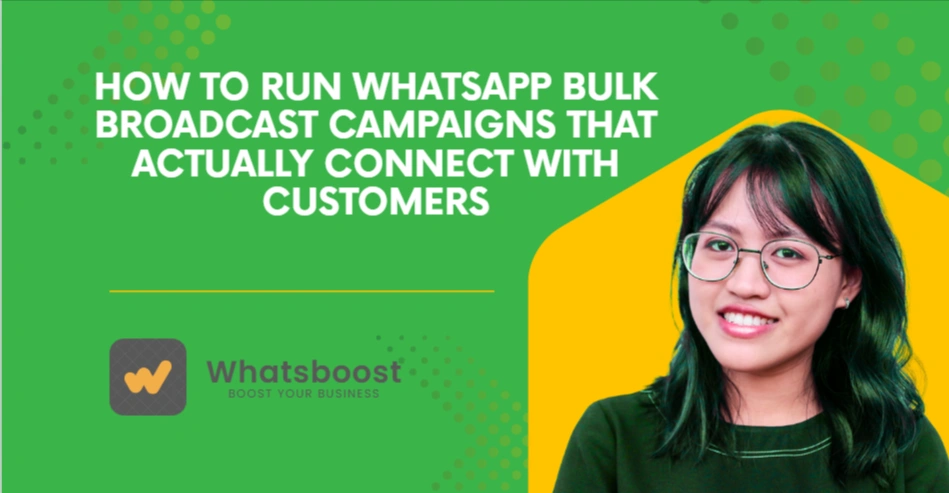
How to Run WhatsApp Bulk Broadcast Campaigns That Actually Connect with Customers
Learn how to send WhatsApp bulk broadcasts without spamming or getting blocked. Discover tips, timing strategies, and examples to boost engagement and sales using Whatsboost.
You already know WhatsApp is where your customers spend most of their time — sharing memes, planning family dinners, discussing office projects. But here’s the challenge: how do you make sure your business message doesn’t just sit there like another unread notification?
Bulk broadcasts are a great way to keep your brand in front of your audience — but sending random messages to everyone is the fastest way to get ignored.
So, let’s talk about how you can craft a WhatsApp broadcast strategy that feels human, drives action, and actually strengthens relationships with your customers — without relying on the WhatsApp Business API.
Step 1: Know the “Why” Before the “Send”
Many businesses skip straight to typing their message. That’s like printing posters without knowing what event you’re advertising.
Ask yourself:
-
Am I trying to get bookings?
-
Do I want to clear old inventory?
-
Do I just want customers to engage with my brand?
Relatable example:
Imagine you run a home décor shop and you just got a new stock of ceramic lamps. Your goal might be to get early buyers. Your broadcast could say:
“Soft light, cozy vibes — our new ceramic lamps are here. Tap to see the designs before they sell out.”
See how it feels like an invitation rather than a sales pitch?
Step 2: Send to the Right People, Not Everyone
Your audience list should be more like a guest list — curated and intentional. Sending every message to every contact only makes people mute you.
Whatsboost lets you import and segment your contacts into groups:
-
Regular buyers
-
Occasional shoppers
-
People who asked but never purchased
That means you can send your lamp announcement only to décor lovers — not to someone who once ordered cleaning supplies six months ago.
Step 3: Write Like a Human, Not an Ad
Here’s the fastest way to get ignored: use loud words and ALL CAPS.
Instead, write how you’d talk to a friendly customer in your store.
Example:
“Hey Priya, we’re bringing back our weekend dessert platter! Would you like me to save one for you?”
It feels like you remembered them — because you did.
Step 4: Add a Little Visual Magic
A good image can speak faster than a hundred words. Show what you’re talking about — a snapshot of the new collection, a short clip of your café’s special drink being made, or even a simple graphic with the offer.
With Whatsboost, you can attach these directly along with a button that says “View Menu” or “Reserve Now.” That way, your customers don’t have to hunt for what to do next.
Step 5: Pick a Time When Customers Will Actually See It
Timing is half the battle.
-
Restaurants and cafés can send lunchtime menus mid-morning.
-
Salons can share appointment slots early evening when people plan their next day.
-
Retailers can drop weekend sales notices on Friday afternoon when paychecks hit.
Test a few timings and see when your customers are most responsive — Whatsboost’s analytics make this easy.
Step 6: Use Smart Follow-Ups (Without Nagging)
Sending one message is like knocking on a door once and leaving. Some customers need a polite reminder — but not five of them.
Here’s a flow that works well:
-
Send your first message.
-
Wait a day.
-
Send a friendly reminder to only those who didn’t open or respond.
-
Do a final “last chance” nudge for the ones who clicked but didn’t act.
This way, you’re talking to people who are actually interested, not spamming everyone on your list.
Step 7: Measure What Worked (and What Didn’t)
Your broadcast is not complete when you hit send — it’s complete when you check the results.
With Whatsboost, you can see:
-
How many people opened the message
-
How many clicked the link
-
Which version of your message got the most response
This helps you get better each time — so you don’t repeat what flopped.
A Quick Story:
A neighborhood florist recently used WhatsApp broadcasts to sell leftover flowers after a wedding event.
Here’s what they did:
-
Sent a quick message with a picture of the flowers and a “50% Off — Same Day Delivery” button.
-
Followed up only with people who didn’t respond within two hours.
-
Sold out the entire stock in one afternoon — and gained repeat customers who now expect these exclusive deals.
That’s the power of planning your broadcast with care.
The Whatsboost Advantage
Most platforms force you to use the WhatsApp Business API, which is costly and complicated for many businesses. Whatsboost gives you the freedom to run these broadcasts without needing the API at all — making it simpler, faster, and affordable for teams who just want to reach their customers reliably.
You can explore how it works here.
Final Thoughts
WhatsApp bulk broadcasts aren’t about pushing out noise — they’re about sending the right message, to the right person, at the right time.
When you use a thoughtful strategy (and the right tool), every broadcast becomes an opportunity to connect — not just promote. And when your messages feel personal, customers are more likely to trust you, buy from you, and stay loyal.
